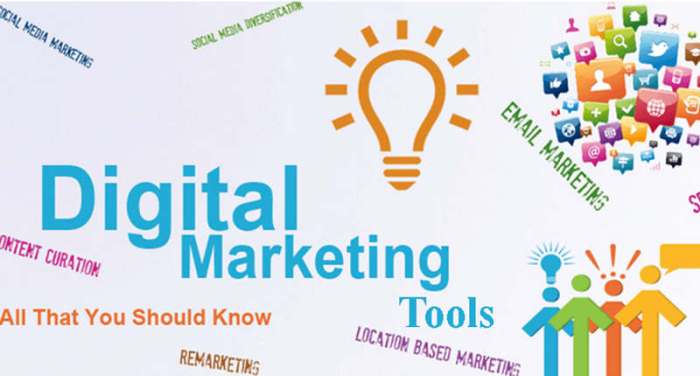
Programmatic advertising tools have revolutionized how businesses approach digital marketing, allowing for automated ad buying and optimized targeting that was once unimaginable. These tools leverage data and technology to enhance user engagement and streamline advertising efforts, making them essential in today’s fast-paced market.
With the evolution of advertising tools, companies can now access a wide array of functionalities that provide insights into audience behavior, drive efficiency, and ultimately, improve return on investment. Understanding the landscape of programmatic advertising is crucial for marketers aiming to stay competitive and maximize their advertising budgets.
Introduction to Programmatic Advertising Tools
Programmatic advertising has revolutionized the way businesses approach digital marketing. It leverages technology to automate the buying and selling of online advertising space, making it more efficient and effective. In a landscape where consumer attention is fragmented across various platforms, programmatic advertising tools play a crucial role in helping advertisers reach their target audiences precisely when and where they are most engaged.The evolution of advertising tools has profoundly impacted businesses, transitioning from traditional manual processes to sophisticated automated systems.
This shift has enabled marketers to optimize their ad spend and gain real-time insights into campaign performance. Effective programmatic advertising tools possess key features such as precise targeting options, real-time bidding capabilities, and comprehensive analytics that support informed decision-making.
Types of Programmatic Advertising Tools
Programmatic advertising tools can be categorized into several types, each serving unique functions within the digital marketing ecosystem. The primary categories include Demand-Side Platforms (DSPs), Supply-Side Platforms (SSPs), and ad exchanges, each playing a vital role in the ad buying and selling process.
- Demand-Side Platforms (DSPs): These platforms allow advertisers to purchase ad inventory in an automated fashion, utilizing data to target specific audiences effectively.
- Supply-Side Platforms (SSPs): SSPs enable publishers to manage and sell their ad space more efficiently, ensuring they receive the best possible price for their inventory.
- Ad Exchanges: Ad exchanges serve as marketplaces where advertisers and publishers can buy and sell ad space, offering transparency and competitive pricing.
Data Management Platforms (DMPs) play a pivotal role in enhancing the effectiveness of programmatic advertising. They collect and analyze large volumes of data from various sources, enabling advertisers to create highly targeted audience segments and improve ad performance.
Benefits of Using Programmatic Advertising Tools
The advantages of programmatic advertising extend far beyond automated ad buying. These tools enable businesses to achieve greater targeting precision, enhanced reach, and improved return on investment (ROI).
- Advanced Targeting: Programmatic advertising allows advertisers to target specific demographics, interests, and behaviors, ensuring that their ads reach the most relevant audiences.
- Cost Efficiency: With real-time bidding and data-driven decision-making, businesses can optimize their ad spend, reducing wasted costs associated with traditional advertising methods.
- Improved ROI: By leveraging detailed analytics and performance metrics, advertisers can continuously refine their campaigns, leading to better overall results.
Implementing Programmatic Advertising Tools

For businesses looking to integrate programmatic advertising into their marketing strategy, a structured approach is essential. The following step-by-step guide Artikels the implementation process.
- Assess Audience Data: Understanding who your target audience is and gathering relevant data is crucial for effective programmatic advertising.
- Select the Right Tools: Choose the appropriate DSPs, SSPs, or ad exchanges that align with your business goals and target audience.
- Integrate with Existing Campaigns: Seamlessly incorporate programmatic advertising tools into your current marketing campaigns for a cohesive strategy.
Challenges in Programmatic Advertising
While programmatic advertising offers numerous benefits, it also presents challenges that businesses need to navigate. Common issues include:
- Privacy Concerns: With increasing scrutiny on data privacy, marketers must ensure compliance with regulations such as GDPR and CCPA.
- Technical Hurdles: Integrating new technology can pose challenges, especially for businesses lacking technical expertise.
- Operational Issues: Understanding and managing the complexities of programmatic advertising requires ongoing learning and adaptation.
Future Trends in Programmatic Advertising
The future of programmatic advertising is poised for significant transformation, driven by emerging technologies.
- Artificial Intelligence: AI will continue to enhance targeting capabilities, optimizing ad placements through predictive analytics.
- Machine Learning: These technologies will allow for more sophisticated data analysis, improving campaign performance over time.
- Blockchain Technology: Blockchain is expected to enhance transparency and security in programmatic transactions, addressing fraud concerns.
Programmatic Advertising and Business Accounting
The financial implications of programmatic advertising tools are substantial. They can streamline business accounting by automating tracking and reporting processes.
- Efficient Reporting: Automating financial reporting can save time and reduce errors associated with manual processes.
- Budget Management: Programmatic tools facilitate real-time budget tracking, enabling businesses to make informed financial decisions.
- Advertising Spend Impact: Understanding the return on ad spend (ROAS) is vital for assessing overall business financial health.
Programmatic Advertising and Human Resources

Programmatic advertising tools can also be leveraged in the realm of human resources, particularly in recruitment efforts.
- Targeted Recruitment Advertising: Using programmatic tools, HR departments can target specific demographics for job postings, enhancing the quality of applicants.
- Employer Branding: Strategic use of programmatic advertising can strengthen employer branding campaigns, attracting top talent.
- Talent Acquisition Strategies: HR teams can utilize data-driven insights to refine their talent acquisition strategies.
Programmatic Advertising and Customer Service
Enhancing customer service through targeted programmatic campaigns is increasingly relevant.
- Targeted Customer Engagement: Utilizing programmatic advertising can facilitate more personalized interactions with customers.
- Successful Strategies: Campaigns that use customer feedback effectively lead to improved service quality and customer satisfaction.
- Feedback Loops: Incorporating customer feedback into advertising strategies is essential for continuous improvement.
Programmatic Advertising in Agriculture
The agricultural sector has begun to adopt programmatic advertising tools to improve marketing strategies.
- Advertising Strategies: Effective advertising strategies for agricultural products include targeting specific audiences interested in farming and related services.
- Case Studies: Successful campaigns in agriculture demonstrate the potential of programmatic tools to increase product visibility.
Architectural and Interior Design Marketing through Programmatic Advertising
Architectural and design firms can benefit from programmatic advertising by employing tailored marketing strategies.
- Promoting Services: Programmatic tools can effectively promote architectural and design services to targeted demographics.
- Targeting Techniques: Utilizing demographic insights allows firms to reach potential clients interested in design.
- Measuring Effectiveness: It’s crucial to measure the impact of advertising campaigns to refine future efforts.
Programmatic Advertising for Business Branding
Building a strong brand identity through programmatic advertising is essential for businesses.
- Integrating Branding Efforts: Comprehensive strategies that incorporate programmatic advertising can strengthen overall branding.
- Successful Campaigns: Examples of effective branding campaigns using programmatic tools highlight their value in creating brand awareness.
Programmatic Advertising in Travel Industry
The travel sector faces unique challenges and opportunities in programmatic advertising.
- Real-Time Data: Utilizing real-time data can enhance the effectiveness of travel advertising campaigns.
- Successful Campaigns: Highlighting successful programmatic campaigns in the travel industry provides valuable insights.
Change Management and Programmatic Advertising
Integrating new advertising tools necessitates effective change management strategies.
- Importance of Change Management: Understanding the need for change is vital for successful implementation of programmatic advertising.
- Framework for Transition: A clear framework can assist businesses in managing the transition to programmatic systems.
- Success Stories: Sharing case studies of businesses that successfully navigated these changes can provide guidance.
Entrepreneurialism and Programmatic Advertising Tools
Startups can leverage programmatic advertising tools to gain a competitive edge.
- Benefits for Startups: Programmatic advertising can help startups maximize their limited resources while reaching targeted audiences efficiently.
- Resource Allocation Strategies: Effective allocation of resources towards programmatic advertising can drive growth and visibility.
- Success Examples: Highlighting entrepreneurial ventures that have effectively utilized these tools can inspire others.
Conclusion
In summary, programmatic advertising tools not only improve the effectiveness of marketing campaigns but also facilitate a deeper understanding of customer needs and preferences. As technology continues to advance, staying informed about these tools will be vital for businesses looking to thrive in the digital landscape and harness the full potential of targeted advertising strategies.
FAQ Section
What are programmatic advertising tools?
Programmatic advertising tools are software solutions that automate the buying and selling of ad inventory in real-time, optimizing the ad placement process and targeting capabilities.
How do programmatic advertising tools work?
These tools use algorithms and data analysis to purchase ad space across various platforms, ensuring that the right ads reach the right audiences at the right times.
What are the main benefits of using programmatic advertising tools?
They enhance targeting accuracy, improve cost efficiency, increase ROI, and allow for real-time adjustments to campaigns based on performance data.
Are there any challenges associated with programmatic advertising tools?
Yes, common challenges include privacy concerns, data compliance issues, and the complexity of managing multiple platforms and technologies.
Can small businesses benefit from programmatic advertising tools?
Absolutely! Small businesses can leverage these tools to compete with larger firms by optimizing their ad spend and targeting specific audiences effectively.





